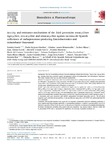Activity and resistance mechanisms of the third generation tetracyclines tigecycline, eravacycline and omadacycline against nationwide Spanish collections of carbapenemase-producing Enterobacterales and Acinetobacter baumannii

Ver/Abrir
Use este enlace para citar
http://hdl.handle.net/2183/40943
Excepto si se señala otra cosa, la licencia del ítem se describe como Creative Commons Attribution-NonCommercial-NoDerivatives 4.0 International License (CC-BY-NC-ND 4.0)
Colecciones
- Investigación (FFISIO) [481]
Metadatos
Mostrar el registro completo del ítemTítulo
Activity and resistance mechanisms of the third generation tetracyclines tigecycline, eravacycline and omadacycline against nationwide Spanish collections of carbapenemase-producing Enterobacterales and Acinetobacter baumanniiAutor(es)
Fecha
2024-12-02Cita bibliográfica
García P, Guijarro-Sánchez P, Lasarte-Monterrubio C, Muras A, Alonso-García I, Outeda-García M, Maceiras R, Fernández-López MDC, Rodríguez-Coello A, García-Pose A, Blanco-Martín T, González-Pinto L, Arca-Suárez J, Vázquez-Ucha JC, Bou G, Beceiro A; Spanish National Acinetobacter spp. 2020 Study Group and GEMARA-SEIMC/REIPI Enterobacterales Study Group. Activity and resistance mechanisms of the third generation tetracyclines tigecycline, eravacycline and omadacycline against nationwide Spanish collections of carbapenemase-producing Enterobacterales and Acinetobacter baumannii. Biomed Pharmacother. 2024 Dec;181:117666.
Resumen
[Abstract]
Introduction: The rise in multidrug-resistant bacteria challenges clinical microbiology. Tigecycline, eravacycline, and omadacycline show promise against carbapenem-resistant Enterobacterales and Acinetobacter baumannii. This study evaluates their activity and resistance mechanisms.
Methods: Two Spanish multicentre collections of WGS-characterized carbapenemase-producing Enterobacterales (n=399) and A. baumannii (n=118) were tested. The MICs of tigecycline, eravacycline, omadacycline and classic tetracyclines were determined. WGS-guided resistome analysis, expression studies, efflux pump inhibition and cloning assays identified potential mechanisms of resistance.
Results: Tigecycline and eravacycline exhibited the highest activity against the whole set of Enterobacterales (MIC50/MIC90 0.5/1 mg/L and 1/2 mg/L, respectively), and A. baumannii (MIC50/MIC90 1/2 mg/L and ≤0.25/1 mg/L, respectively). Omadacycline showed no improvement relative to classic tetracyclines (MIC50/MIC90 values of 8/32 mg/L and 8/16 mg/L for Enterobacterales and A. baumannii, respectively). Resistance mechanisms in Enterobacterales included efflux pumps (AcrAB-TolC, OqxAB) and mutation in their regulatory genes. In A. baumannii, adeS gene mutations and adeABC upregulation decreased tigecycline activity. The prevalent sequence types with reduced susceptibility to eravacycline and tigecycline were ST307 in K. pneumoniae and ST2 in A. baumannii.
Conclusion: Eravacycline remains a key agent for the treatment of bacterial infections exhibiting promising efficacy against multidrug-resistant pathogens. As an empirical antibiotic it could be a good alternative for severe infections caused by CPE or CRAB, however, its clinical use is limited by the absence of standardized breakpoints. Resistance mechanisms, including efflux pumps and gene mutations, vary among isolates. High-risk clones like K. pneumoniae ST307 and A. baumannii ST2 underscore the necessity of prudent antibiotic use.
Palabras clave
Acinetobacter baumannii
Antimicrobial resistance
Carbapenemase-producing Enterobacterales
Eravacycline
Omadacycline
Tigecycline
Antimicrobial resistance
Carbapenemase-producing Enterobacterales
Eravacycline
Omadacycline
Tigecycline
Descripción
Multicenter study
Versión del editor
Derechos
Creative Commons Attribution-NonCommercial-NoDerivatives 4.0 International License (CC-BY-NC-ND 4.0)
ISSN
0753-3322






